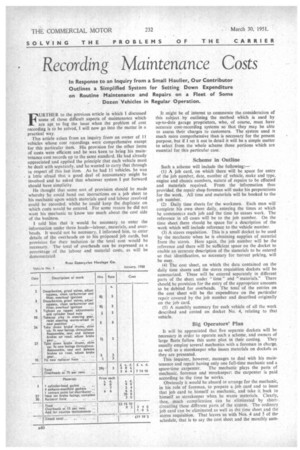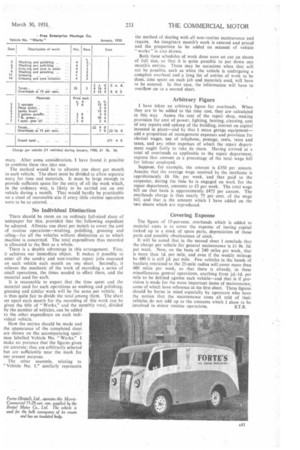• Recording Maintenance Costs
Page 50

Page 51

If you've noticed an error in this article please click here to report it so we can fix it.
In Response to an Inquiry from a Small Haulier, Our Contributor Outlines a Simplified System for Setting Down Expenditure on Routine Maintenance and Repairs on a Fleet of Some Dozen Vehicles in Regular Operation.
FURTHER to the previous article in which I discussed some of those difficult aspects of maintenance which are apt. to fog the issue when the problem of cost recording is to be solved, I will now go into the matter in a practical way.
This article arises from an inquiry from an owner of II vehicles whose cost recordings were comprehensive except for this particular item. His provision for the other items of costs were efficient and he was keen to bring his maintenance cost records up to the same standard. He had already appreciated and applied the principle that each vehicle must be dealt with separately, and he.wanted to carry that through in respect of this last item. As he had 11 vehicles. he was a little afraid that a good deal of accountancy might be involved and he asked that whatever system I put forward should have simplicity He thought that some sort of provision should be made whereby he could hand out instructions on a job sheet to his mechanic upon which materials used and labour involved could be recorded. whilst he could keep the duplicate on which costs would be entered. For some reason he did not want his mechanic to know too much about the cost side of the business.
I told him that it would be necessary to enter the information under three heads—labour, materials, and overheads, It would not be necessary, I informed him, to enter details of the overheads on to his proposed job cards, but provision for their inclusion in the total cost would be necessary. The total of overheads can be expressed as a percentage of the labour and material costs, as will be demonstrated.
It might be of interest to commence the consideration of this subject by outlining the method which is used by up-to-date garage proprietors, who, of course, must have accurate cost-recording systems so that they may be able to assess their charges to customers. The system used is much more comprehensive than is necessary for the present purpose, but if I set it out in detail it will be a simple matter to select from the whole scheme those portions which are essential for this particular case.
Scheme in Outline Such a scheme will include the following:—
(1) A job card, on which there will be space for entry of the job number, date, number of vehicle, make and type, engine and chassis numbers, nature of repairs to be effected and materials required. From the information thus provided, the repair shop foreman will make his preparations for the work. All time and materials will be booked to the job number.
(2) Daily time sheets for the workmen. Each man will complete his own sheet daily, entering the times at which hp commencl:s each job and the time he ceases work. The reference in all cases will be to the job number. On the time sheet. there should be space for a description of the work which will include reference to the vehicle number.
(3) A stores requisition. This is a small docket to be used by the mechanic when he is obtaining supplies of material from the stores. Here again, the job number will be the reference and there will be sufficient space on the docket to enable an accurate description of the materials to be entered so that identification, so necessary for correct pricing, will be easy.
(4) The cost sheet, on which the data contained on the daily time sheets and the stores requisition dockets will be summarized, These will be entered separately in different parts of the sheet under "time" and "materials." There should be provision for the entry of the appropriate amounts to be debited for overheads. The total of the entries on the cost sheet will be the expenditure on the particular repair covered by the job number and described originally on the job card.
(5) A monthly summary for each vehicle of all the work described and costed on docket No. 4, relating to that vehicle.
Big Operators' Plan
It will be appreciated that five separate dockets will be necessary in order to operate such a scheme, and owners of large fleets follow this same plan in their costing. They usually employ several mechanics with a foreman in charge, as well as a storekeeper who issues materials on dockets as they are presented.
This inquirer, however, manages to deal with his maintenance and repair having only one full-time mechanic and a spare-time carpenter. The mechanic plays the parts of mechanic, foreman and storekeeper: the carpenter is paid according to the time he works.
Obviously it would be absurd to arrange for the mechanic, in his role of foreman, to prepare a job card and to issue that job card to himself as mechanic, and take it back to himself as storekeeper when he wants materials. Clearly, then, much complication can be eliminated by short-. circuiting these different parts of the system. The ordinary job card can be eliminated as well as the time sheet and the stores requisition. That leaves us with Nos. 4 and 3 of the schedule, that is to say the cost sheet and the monthly sum
mary. After some consideration, I have found it possible to combine these two into one.
The method would be to allocate one sheet per month to each vehicle. The sheet must be divided to allow separate entry for time and materials. It must be large enough to provide sufficient space for the entry of all the work which, in the ordinary way, is likely to be carried out on one vehicle during a month. That would hardly be practicable on a sheet of reasonable size if every little routine operation were to be so entered.
No Individual Distinction
There should be room on an ordinary full-sized sheet of notepaper for this, provided that the following expedient be adopted. Allocate one sheet per month to cover the cost of routine operations—washing, polishing, greasing and oiling—for all the vehicles without distinction as to which machine is concerned. The total expenditure thus recorded is allocated to the fleet as a whole.
There is a double advantage in this arrangement. First, it achieves our immediate object. It makes it possible to enter all the sundry and non-routine repair jobs executed on each vehicle each month on one sheet. Secondly, it relieves the mechanic of the work of recording a series of small operations, the times needed to effect them, and the material used for each.
It is reasonable to expect that the time spent and the material used for such operations as washing and polishing, greasing and similar work will be the same per vehicle. It is thus quite fair to divide the total among them. The sheet set apart each month for the recording of this work can be given the title of "Works," and the monthly total, divided by the number of vehicles, can be added to the other expenditure on each individual vehicle.
How the entries should be made and the appearance of the completed sheet are shown on the accompanying specimen labelled Vehicle No. " Works." I make no pretence that the figures given ire accurate: they are arbitrarily selected but are sufficiently near the mark for our present purpose.
The other example, relating to "Vehicle No. 1," similarly represents the method of dealing with all non-routine maintenance and repairs. An imaginary month's work is entered and priced and the proportion to be added on account of vehicle "works" is also shown.
Both these schedules of work done were set out on sheets of full size, so that it is quite possible to put down one month's entries. There may, be occasions when that will not be possible, such as when the vehicle is undergoing a complete overhaul and a long list of entries of work to be done, time spent on each job and materials used, will have to be entered. In that case, the information will have to overflow on to a second sheet.
Arbitrary Figure
I have taken an arbitrary figure for overheads. When they are to be added to the time cost, they are calculated in this way. Assess the rent of the repair shop, making provision for cost of power, lighting, heating, cleaning, cost of any repairs and upkeep of the building, interest on capital invested in plant—and by that I mean garage equipment— add a proportion of management expenses and provision for clerical wages, use of telephone, postage, rents, rates and taxes, and any other expenses of which the repair department ought fairly to take its share. Having arrived at a total of overheads as applicable to the repair department, express that amount as a precentage of the total wage bill for labour employed.
Suppose, for example, the amount is £150 per annum. Assume that the average wage received by the mechanic is• appraximately £6 10s. per week, and that paid to the carpenter, during the time he is engaged on work for the repair department, amounts to E3 per week. The total wage bill on that basis is approximately £475 per annum. The overheads charge is thus nearly 75 per cent, of the wage bill, and that is the amount which I have added on the two sheets which are reproduced.
Covering Expense
the 'figure of 15-per-cent, overheads which is added to material costs is to cover the expense of having capital locked up in a stock of spare parts, depreciation of those parts and possible obsolescence of stock.
It will be noted that in the second sheet I conclude that the charge per vehicle for general maintenance is £1 Os. 5d. per week. Now, on the basis of 240 miles per week, that is more than Id. per mile, and even if the weekly mileage be 480 it is still id. per mile. Few vehicles in the hands of hauliers restricted to the 25-mile radius will cover more than 480 miles per week, so that there is already, in these miscellaneous general operations, anything from per mile to be debited against each vehicle—and that is if provision is made for the more important items of maintenance, some of which have reference in the first sheet. These figures should be borne in mind especially by operators who have the notion that the maintenance costs all told of their vehicles do not add up to the amounts which I show to be involved in minor routine operations. S.T.R.












































































